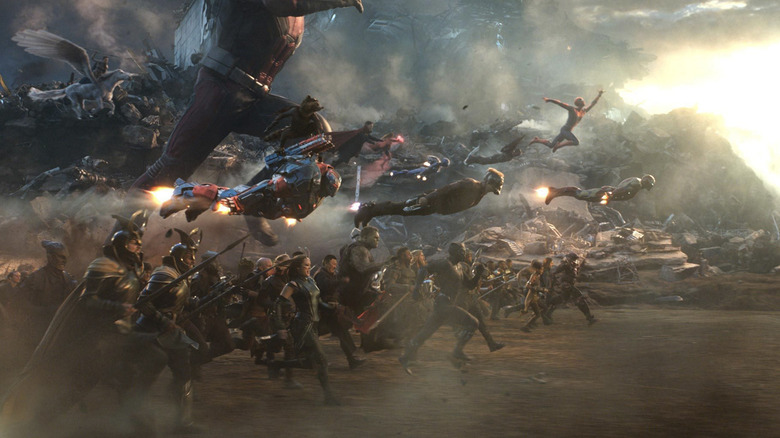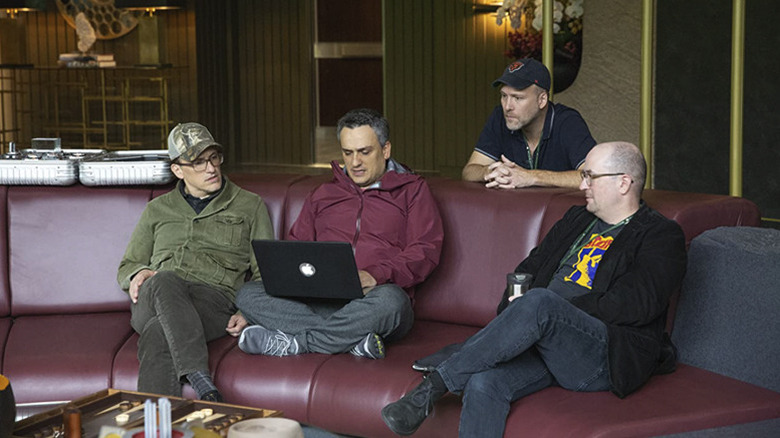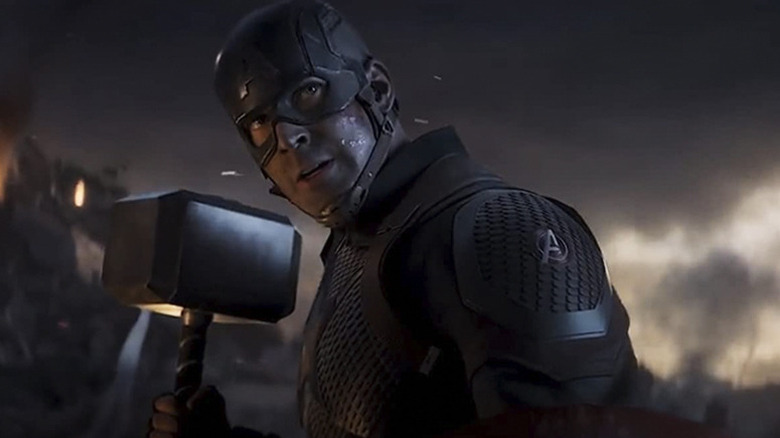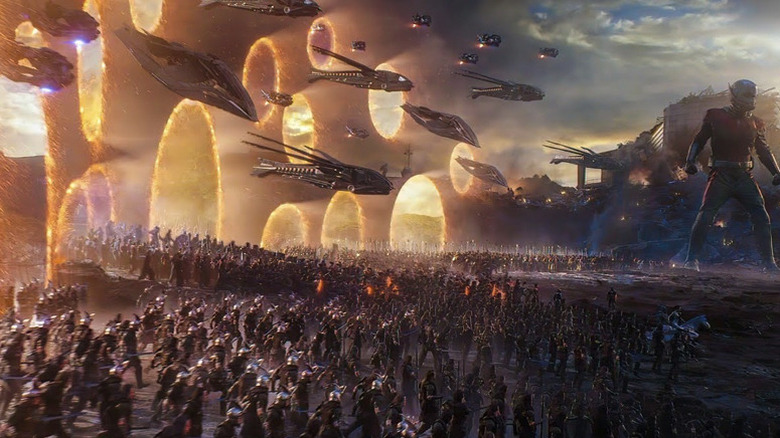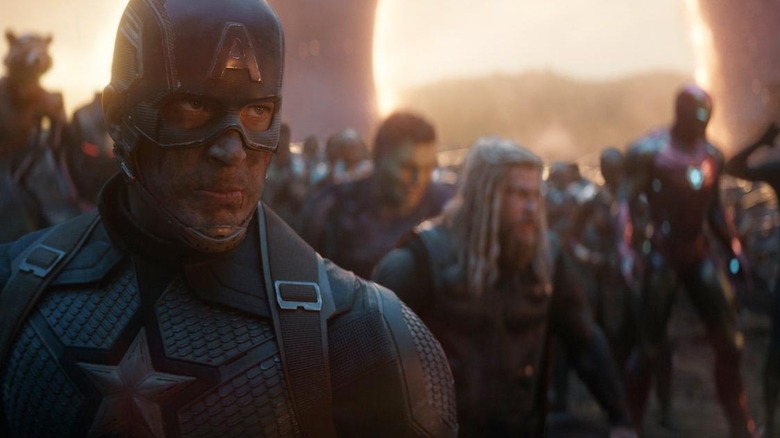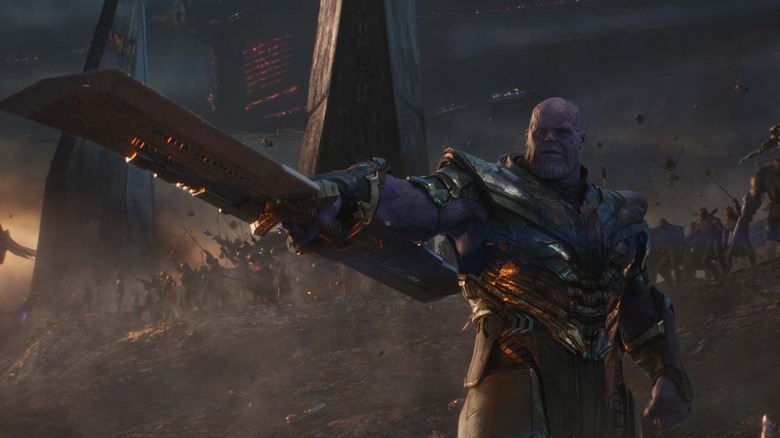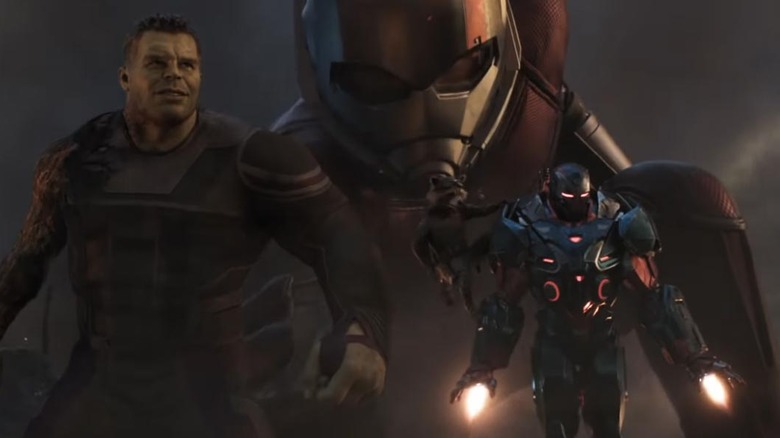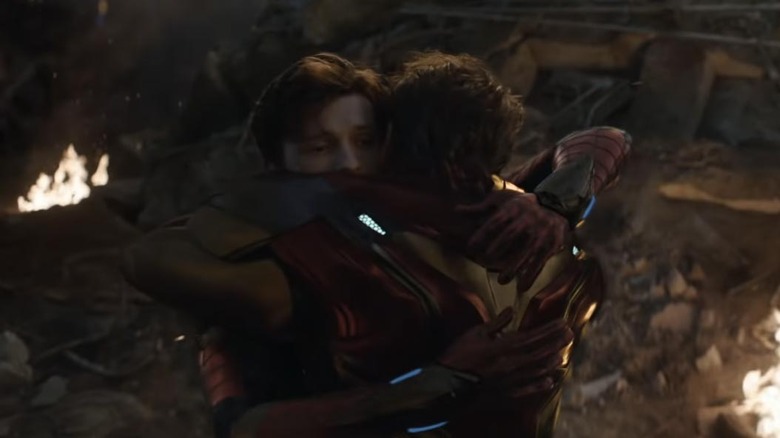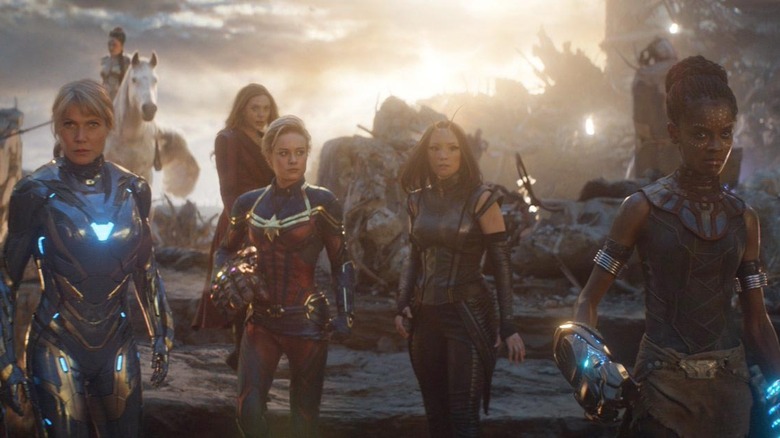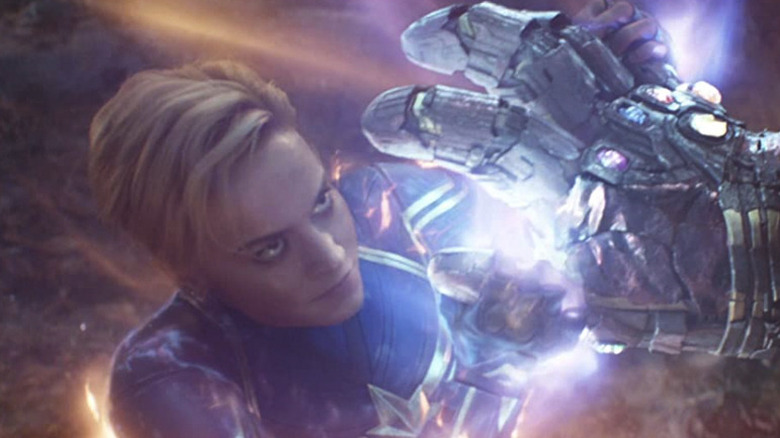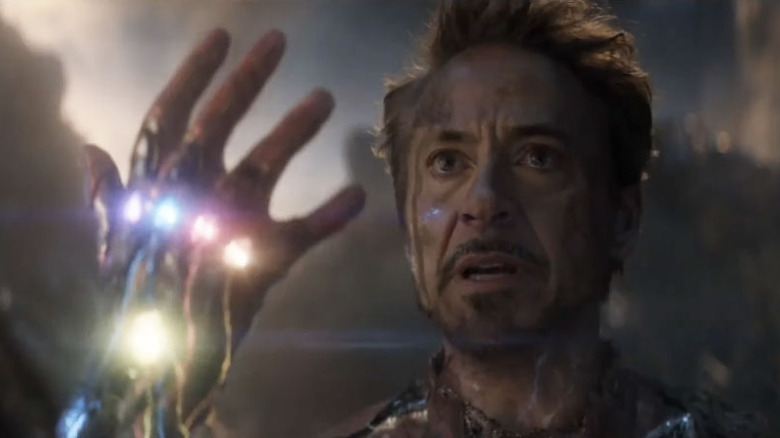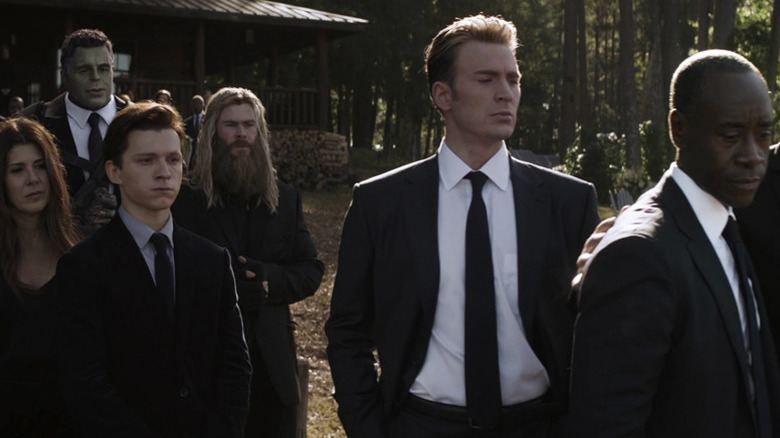Avengers: Endgame Final Battle Oral History: How The Biggest Scene In Comic Book Movie History Came Together
As the narrative conclusion of 22 films in the Marvel Cinematic Universe, "Avengers: Endgame" needed to end with a scene so large, it could contain the dozens of characters who'd been established by that point. The film's colossal final battle fit the bill: It's a gargantuan confrontation with Thanos and his alien armies on one side and Captain America, Thor, Iron Man, and all of the surviving heroes on the other.
It's such a spectacular clash that it instantly became the biggest comic book movie moment of all time. This is the oral history of how that epic scene — from the destruction of Avengers HQ all the way until Tony Stark's devastating sacrifice — came together, as told by the people who helped shape it.
Note: These interviews have been lightly edited for clarity and brevity.
Conception
"Avengers: Infinity War" and "Avengers: Endgame" were essentially filmed back to back, but writers Christopher Markus and Stephen McFeely were developing ideas for "Endgame" years before production began, back when they were still working on 2016's "Captain America: Civil War" with eventual "Endgame" directors Anthony and Joe Russo. But Marvel Studios President (and "Endgame" producer) Kevin Feige had ideas about this scene long before that.
Trinh Tran (Executive Producer): I think it's always been a dream to make "Infinity War" and "Endgame." It's always been in Kevin's mind that if we get lucky enough to get there, this is the story we want to tell. It's not that it's super detailed, that we knew every detail that was going to happen. We knew that Thanos was going to be the end point if we get there, and we're teasing it throughout the way. We knew that we're going to be closing the chapter to certain characters and that's going to be paving the path for introducing new characters, so there's certain elements that we knew early on, and it was about piecing it together.
Christopher Markus (Co-Writer): In late 2015 when we were outlining both ["Infinity War" and "Endgame"], we had the idea that we were going to kill Thanos, then find old Thanos and he would come back to our time and wreak havoc. The nature of that havoc changed a few times ... it was always sort of, "Hell comes to Avengers compound," which has been a place of peace prior to this point. "You tried to save the world? It's going to come right back here."
Trinh Tran (Executive Producer): I think in Kevin's mindset, the dream is that everybody appears at the end, and they're fighting against Thanos. I think that, overall, it was like, "That would be amazing, if we have every single hero that we've had, ever in the MCU, appear." I think that's the starting point, and from there, we built on in terms of OK, who disappeared from the previous movie so they can come back on? Who was interacting with who? We obviously don't want it to be that they're fighting for the sake of fighting. These characters have to have significance –- why are they there in this position? So all that started getting laid out.
Jeff Ford (Editor): The end battle in "Endgame" underwent a lot of changes over the course of writing. We actually didn't photograph most of the end battle until 2018. We shot most of that sequence in October of 2018 with three units in Atlanta. It was a crazy month of crazy mo-cap. One of the reasons we didn't shoot it during the initial production phase was the movie was evolving and "Infinity War" was evolving. We had two movies that were going to interact with each other and affect each other, but we didn't want to repeat ourselves or get in the same rhythms, and we wanted to make sure that we delivered a unique final battle for the final battle. Which was ultimately the final battle for a few people. So what we did is we decided, let's just punt on that one. Let's get the rest of the movie together and see where we need to go. We knew where we were headed, and we had already shot Tony's demise, and we had already shot the scene at the lake and the epilogue. We'd also shot Hawkeye in the tunnels and stuff like that — but we hadn't done the big heavy lifting part. We also hadn't figured out how they were coming out of those portals yet. We knew kind of what we were going to do, but that underwent a huge change and then the reshoot changed that significantly, and for the better.
I knew it!
After Thanos (Josh Brolin) destroys Avengers HQ, Iron Man (Robert Downey Jr.) and Captain America (Chris Evans) join Thor (Chris Hemsworth) for a 3-on-1 fight on the destroyed ruins of the compound. When Iron Man is put out of commission and Thor is on the ropes, one of the movie's most crowd-pleasing moments happens: Captain America picks up Thor's hammer, Mjolnir, proving once and for all that he's worthy.
Stephen McFeely (Co-Writer): It was a 3x5 card on the board early on. It was actually in the [outline] that we gave Marvel in the summer of 2015. "Cap picks up Thor's hammer." And it was like, "Yeah, we're doing that somewhere." I remember debating about whether we should see — I think we shot it both ways — you see Cap, he looks at Thor and Thor is so screwed, and then Cap looks over and he sees the hammer. Do you reveal it that way first? You could do it any number of ways.
Dan Laurie (Supervising Sound Editor): Thor and Thanos have a big fight. Thor's got his hammer, and that's got a very distinctive noise – even though it was changed because there was lightning coming from the sky, they had to put sounds onto that. It's evolving, because it's different to the next film, so they had to do that. But then he's fighting with Thanos, and Thanos had this double-edged blade thing that he fights with. I don't know what it's called. I don't even think it had a name. But we'd have to have a distinctive noise for that, because we don't want Thor's hammer and that sounding the same. [The designer] recorded a load of metal hits and then stretched it out and then put it through a modulator to make it sound like it was spinning.
Christopher Markus (Co-Writer): There was certainly a debate at one point because particularly in "Ragnarok," it establishes that Thor can summon the lightning without the hammer. I think Odin even says, "It was never the hammer." And yet Cap summons the lightning with the hammer. You get to those things and you're like, "It's too awesome not to do it! We'll talk about it later."
Alan Silvestri (Composer): The thing that Joe and Anthony struggled with, and I think did a magnificent job of solving, was how high do we let the audience get knowing that we're really going to pull the rug out? That moment when Cap gets the hammer, we were in Westwood on preview night the Thursday night before opening night. When that happened, that place stood on its feet and screamed. It was the biggest reaction in the movie. It was very tempting to give it all away [by using the full Avengers theme at that moment], but what we knew was, we're about to destroy Cap little by little, and we want everybody to be right there, that this is hopeless because the real moment is the reuniting of all of the Marvel universe to help him. So that was one of those brilliant Joe and Anthony decisions. "No, don't take it. Leave it over there. Resist."
Trinh Tran (Executive Producer): I remember how excited Chris [Evans] was. Obviously he's read his scene and knew what was going to happen, but when you're standing there holding it and lifting it up, it's a pretty amazing feeling. I think the excitement on him was so captivating. I know there were certain moments – people portal-ing in, him holding the hammer – there are certain moments where they're so excited, and having him lift it up was gratifying knowing that what we had teased in "Ultron" kind of came to an end in terms of, he really can lift it. I can't describe it. I didn't grow up reading comics, but I was geeking out over the fact that I got to see that.
Jeff Ford (Editor): I cut the Avengers trying to pick up the hammer scene in "Ultron," so I remember endless conversations with ["Avengers: Age of Ultron" director] Joss [Whedon] about, "He's going to be able to do it. Of course he can. He's Cap!" But we didn't want to give it away and we really wanted to tee that up, and I love that scene. I think seeing that realized is one of the pleasures of a long series like this, where you've really been with these characters for a long time, so when that happens, it's not satisfying unless you buy it, and I buy it. Because Cap is that guy. And it's not satisfying unless it makes sense for the moment in which it's placed in the narrative that it's in. You can't just, "Oh, by the way, he picked up the hammer now."
Matt Aitken (Visual Effects Supervisor, WETA Digital): We just knew that was going to be a thing. When you see Mjolnir lifting up off the ground slowly, you know it's not Thor, because he's being dealt to by Thanos. It's as much a surprise to him as it is to everybody else. But that shot where we whip-pan with the hammer and see Cap holding it, the crowd goes crazy at that point. We did three versions of that shot. The one that ended up in the film, there's no lightning on Mjolnir, but we did a little bit of lightning and then a bit more lightning as well, and we presented them to the filmmakers and they were editorially able to play around with which one they went with.
Jeff Ford (Editor): There were two takes that worked. We flopped back and forth for a minute, but for the most part, there's a thing Evans does at the end of the take where he sets himself. It's money ... It's a beautiful piece of choreography that he came up with. It was during a reshoot that we shot a bunch of lines from Thor for what he would say, but the best one was, "I knew it." We had him on that rock and we were like, "Say this, and this, now this." He had to catch a flight. We had one day where we had to get a lot of Hemsworth. We were sharing him with another show and it was a reshoot thing.
Stephen McFeely (Co-Writer): He hurt his back, so we lost him for a while.
Jeff Ford (Editor): So I remember it was like Hemsworth day. There were like five cameras set up, and he'd go from each camera and do a different piece of performance for a different part of the fight. He's so great, he can do that. But he was awesome, he was such a trooper, and we shot all of his close-ups, because then we'd go back and work with a double. I'm wracking my brain, and I cannot remember what [Thor's unused, alternate reactions] were.
Christopher Markus (Co-Writer): They might have all been "I knew it," just with different spins. The one that's in the script is happy. I'm sure there was some jealousy, some resentment, some shock – it's such a happy moment for the audience that I'm glad we went with the happy one for Thor, because he's sort of the voice of the audience going, "F*** yes!"
Jeff Ford (Editor): It's a great reversal in that fight, too, and we needed it there. I think it's a great way to set that off. The thing that takes it home, again, is Silvestri's score, which is a quote from the Cap score right there.
The cavalry arrives
Captain America stands alone against Thanos and his hordes of soldiers on the battlefield, and all seems lost. But suddenly he receives a message from Falcon (Anthony Mackie) in his earpiece, and as he turns around, portals begin to open, and we see the return of every Marvel hero who had been dusted by Thanos in Infinity War.
Stephen McFeely (Co-Writer): The first draft looked one way ... some of it's the same. The ship appears. Kaboom. Creates a new battlefield, that was a big part of it. They get separated. In the first version, they were all together, because we hadn't quite cracked it.
Christopher Markus (Co-Writer): And everyone came back immediately. There wasn't that cavalry moment. They all came back when [Hulk] snapped. On a storytelling level, it really just killed the momentum of the movie.
Jeff Ford (Editor): In the original version, the portaling was pretty much as scripted, but it happened very quickly. It also happened in a way that was happening sort of around Cap. The conceptual change that we made was that Cap would experience that and we'd see it from his point of view. So the idea of hearing Falcon come out, and it starts, and he turns, and we thought, "Who's going to walk out of there that's going to be the most significant person? When that battle is joined, who do you want to walk out of there?" And it's like, "Oh, it's Okoye, Shuri, and Panther." So that idea was something that kind of evolved as we were talking about the sequence, and we designed a way to do that, that then demanded we do, "Well, wait a minute, now it's a cascade of all these other portals from other places." And we had to very carefully modulate who it would be, knowing that when Cap sees Spidey, those are character connections that make sense from the earlier stories, but also, it's what the audience is also keying on. It keeps happening and keeps happening.
Stephen McFeely (Co-Writer): We shot it a couple of times. The first time, it was quicker. It was very powerful, and I would say exciting, like, "Holy crap, they're back!" And the music was at a 10 early, and you zipped around. I liked it a lot, but Joe and Anthony were absolutely right to reshoot it, because everybody didn't get their hero shot. Classic old-school Hollywood filmmaking where people step into the shot and the crowd goes, "That guy's back!" and you love him for, like, five seconds. That's what it is now.
Christopher Markus (Co-Writer): You get caught up in the logic of it and you go, "Well, they're going to have to come back and they're going to have to spend some time talking about what the hell has been going on, so we'll need a time cut..." It was only eventually when it occurred to us that you could say that somehow Strange had held a little seminar prior.
Stephen McFeely (Co-Writer): Or that you could separate [Hulk's snap] from seeing them. They didn't have to be right on top of each other. That gap of, what turned out to be like twenty minutes, was super helpful.
Jeff Ford (Editor): Originally they came through several [portals], but they opened continuously at once. In other words, there wasn't one, and then another, and then another. So the staging in of that process wasn't the way it was originally envisioned. And Cap was just standing there as this happened. The audience saw it, but he didn't turn around and go, "Oh my God." I think Evans — I remember the day we shot that, I was standing right next to him when we were shooting that scene where Evans sees it, and he's playing just his POV of Panther where he nods. I literally was tearing up and saying, "Chris, this is amazing." That's why I love Evans: He will bring it, and he'll bring it in a way that's on a performance level that's higher than you ever expected, and it's really complex. He's such a minimal actor, too. He doesn't do a lot, but when he does it, it's just so affecting. He did that, and it blew my mind. I'm like, "I'm using that. I know the piece I'm using, I know exactly what I'm using before I go back to the cutting room." The nod.
Stephen McFeely (Co-Writer): So it takes a while, which means you needed a big piece of score that took a while from Silvestri, which meant you couldn't start it at 10. It was so fascinating. I can't remember how many versions he did, he certainly did more than one, but [when the] one finally came in, you go, "Oh, OK this works now." It took so long for everybody to get on the same page.
Sarah Finn (Casting Director): An Academy Award should go to the producer, who had to get everybody on set and match up all their schedules.
Trinh Tran (Executive Producer): I didn't think it was possible. Here's the thing: We had an amazing crew. Our line producer was amazing and able to logistically make it happen and got everybody there. Scheduling was pretty difficult because obviously they had other projects that they were working on. If you really look at it, there are certain scenes where we would have a double for the back of their head because we couldn't get so-and-so on that set on that particular day. There are two instances where we actually did get everybody. That's the wedding scene – you know what I'm talking about and we, until this day, are still calling [the funeral] the wedding scene — that's that one shot with everybody there. That was spectacular. And then second one was when all the heroes portaled in. It was such an incredible feeling to stand there and watch every single one of them in their hero costumes walking out of that. I think, by far, that was the most crew we had.
Matt Aitken (Visual Effects Supervisor, WETA Digital): We really just see Titan really clearly in one of the portal shots, but it's a key shot because we have Drax and Mantis and Strange and we see Quill turn up, and everybody's waiting to see Spidey, because everybody was devastated by Spidey's blip at the end of "Infinity War" ... you know people are recognizing Titan, they see Strange and Drax and Mantis, and they think, 'Ah, this is potentially where Spidey's going to come.' And they see Quill, and they go, 'Oh my God, there's only one person missing from Titan now,' and you see him start to web in in the background, and the crowd just goes crazy at that point. It's just amazing. The payoff is huge. But getting everybody together for that one was tricky. We had Drax and Mantis together, we got the two of them. Strange was necessarily on a different plate because he's floating, so he shot separately on a green screen. Chris Pratt wasn't available on that day, so we picked him up later on with a separate motion control green screen element. And Tom Holland for Spidey had to be another day again, so there's actually four different plates for that one shot.
Sarah Finn (Casting Director): Looking at it just from the breadth and the scope of actors and talent that's coming together and characters that the audience has come to know and love, I think that is one of the great moments in movie history, when everybody comes bursting through. I'm all about the characters and the actors, and I think that from an audience standpoint, to have had the time to get to know these characters and connect with them, and then to suddenly see them uniting forces, all of our central characters – Captain America, Thor, Star-Lord -– but then the whole scope of the Marvel universe and the caliber of talent. I think we have 19 Oscar winners and 28 nominees on screen together. To take a moment and realize it's this exciting, action-packed moment, but the level of talent that's acting out this battle is also something that's very uncommon and very special.
Trinh Tran (Executive Producer): I'm not kidding you, everybody was geeking out over everybody else. It wasn't like, "Oh, you're in a Star-Lord costume, or you're in a Black Panther costume." It was, "Oh my God, I'm standing [next to you!]" It's funny because you think our talent is so used to that, but they were absolutely feeling the same way that I or you or anybody was feeling on that day, because they were seeing each other in that costume, but you're seeing everybody from the last decade, from Tony Stark to Thor to Captain Marvel. So it was a pretty amazing feeling.
Matt Aitken (Visual Effects Supervisor, WETA Digital): [Howard the Duck] ended up not featuring in the end battle, but very late in the day -– and I think it might have come from Kevin Feige, actually -– we got the note that if there was a chance, to get Howard the Duck in. There was this one little gap when the Ravagers were coming out of Contraxia where there was room to drop him in, and he wouldn't be too obvious, which is good. It was the way they wanted to play it. It would involve us essentially building and rigging and shading and prepping a hero digital character for one tiny little beat. I've counted, he's actually in eighteen frames of the film. So it's not like a huge presence. That's a lot of work for a small amount of time. But we were so delighted to be able to do that, and what we heard that when we sent the shot through and it was reviewed in the screening room at Marvel with the filmmakers, they were all clapping and cheering to see Howard.
Christopher Markus (Co-Writer): I remember there was one with temp score where, totally unintentionally on peoples' part, but because the Wakandans come out, and they kind of come out of a sunny haze and they do it slowly, and the music was sort of ethereal and semi-somber, it seemed like Cap was going to heaven. Like he was about to be killed, and then it went "La la la la," and they were like, "No! Come." My head goes to the wrong place there.
Jeff Ford (Editor): I worked on that portal sequence, off and on, for nine months. Probably a little bit every day for those nine months.
Matt Aitken (Visual Effects Supervisor, WETA Digital): The way the portal sequence plays out is immensely satisfying. The way it was written and conceived by the filmmakers, I knew it had the potential to be an amazing sequence within the film. People say it's the most emotional moment of the whole film for a lot of people, I think. And I didn't want bad visual effects to detract from that. So we put a lot of effort into making that stuff work really, really well. All those environments are full 3D CG environments so that they track with the moving cameras incredibly accurately. We wanted it to look beautiful as well, you know? This is a glorious moment. We've got these giant portals, there's sparks drifting around, there's nice color complexity in the shots. So yeah, I definitely didn't want to make a mess of it, and I think it worked out OK, and it's had a fantastic reaction from the audience both times I've seen it, so it's been wonderful.
Avengers ... assemble
With the entire roster of surviving MCU heroes lined up, the camera travels down the line of characters in what co-writer Stephen McFeely described as "the biggest oner scene in the history of the Avengers." The camera stops on Captain America as he catches Thor's hammer and, as an inspirational battle cry, finally says the two words fans have been waiting to hear.
Jeff Ford (Editor): We also realized, "Where do we put the Avengers theme break? We know we're going to play that theme — where does it happen?" We tried a million different ways to do it, and then we realized it ain't gonna happen until [Cap] says "Assemble." Once we figured that out, musically we knew that Alan Silvestri would write us this incredible thing that contained all of that emotion, because there's the emotional, and then there's the visceral, and the visceral comes after Cap says go, which is "Assemble." So once we figured out that structure, we were just giddy, because it all came to life.
Alan Silvestri (Composer): The Avengers theme, because of how it was received in the original "Avengers," just became this kind of golden asset that just sat there. It's tempting to just go, "Use some of that." Joe and Anthony were very mindful of the fact that if they abused that, then it wouldn't be there for them when they really needed it. [The "Avengers assemble" moment] was amazing because we're building with the portals theme. It's a new theme, it's this anthemic, kind of, "Here we go" [track]. And then we're using that part of the Avengers theme, that "duh-duh...duh-duh," which we saw when Hulk was coming up in the original "Avengers," so we know, "OK, they know what comes after that," and we're just winding it up. When Cap gets the hammer [in that oner shot], we stop, and he says the line in silence. Then it's like lights go on at a surprise party. The Avengers just can't get there fast enough! And we thought, "Everybody's earned that tune now."
Trinh Tran (Executive Producer): I think that was Kevin's highlight of all time. To be able to finally put those two words together and have him actually say it. We could have been happy if it ended there, you know? We knew that we wanted that to happen in "Endgame," and it was trying to find, obviously, the right moment, and what other right moment than when everybody's standing behind you and they're ready to go? But I do vividly remember him: It was all green screen, all the characters were standing there, and Chris Evans was holding that, and when he actually first said it, I think it was silence before they all started charging, and we all felt that energy, that surge of, "This is happening. We're going for it!"
Christopher Markus (Co-Writer): [It was satisfying] to get that [line] into a movie and have it literally be at a point of assembly, because it's an odd battle cry when you're all together. But also to sync it up with the hammer catch and the way Evans undercuts it.
Stephen McFeely (Co-Writer): That's Joe, Anthony, and Chris blocking and rehearsing on the day and deciding the best version of it.
Trinh Tran (Executive Producer): I wish I were able to actually read [Kevin's] mind, because I remember him being there — he specifically flew in for the portal opening moment in Atlanta. I remember him talking to me afterwards and he said, "That was the best moment I ever felt." We all got chills, because when [Cap] uttered those words, those are what we've been wanting to hear for over a decade.
Clash of the titans
With the battle cry uttered, the two sides begin to run at each other. It's like a massive comic book splash page come to life. And then the full-scale battle begins.
Dan Laurie (Supervising Sound Editor): The final battle, the real challenge there is that someone told me we had 36 different characters in that scene, all with individual sound design, all doing something different. So that sound design has evolved from the last film they were in. It was a massive challenge to keep that going, put unique sounds on them, and be in the middle of a battle with people running around, with this fantastic music. The challenge there was to keep the story going, to understand what people are saying, not be too loud, because we're always very careful — I can't stand stuff that's too loud. We don't want to exhaust the audience in these massive battle scenes.
Alan Silvestri (Composer): There are some basic physics going on acoustically. The ears, if they are overly assaulted, will literally shut down as a survival mechanism. So what happens is, if you don't find a way to give the audience's ears a rest, especially in a challenging acoustic environment like that, they'll shut down. Then, no matter what you do, they won't open back up in time. So we were very aware of the fact that we have to drive this as hard as we could and make it as exciting as we could, but when there was an opportunity to take our foot off the gas, we were very clear about embracing that. We didn't want to beat the audience up. It wouldn't help.
Matt Aitken (Visual Effects Supervisor, WETA Digital): The environment underwent a big change after the plates for the battle were filmed ... they were shooting on multiple stages with multiple units running at the same time. We have the Avengers compound, which is on the banks of the Hudson River in upstate New York with woods around it. So the environment would be a combination of destroyed built environment, with certainly dirt, a lot of rubble and building elements, but also some busted trees and tree stumps and burnt out trees. But when it was all cut together and assembled in a rough cut with pre-vis, those tree stumps that they'd dressed the sets with became a bit more prevalent than they had anticipated and wanted the scene to look like. Because it sort of read more like they were fighting in the ruins of a bombed out forest rather than the ruins of a bombed out Avengers compound. So for a majority of the sequences, we actually ended up roto-ing the characters off the environment and replacing the environment with a fully CG bombed out crater.
Jeff Ford (Editor): We didn't really shuffle it around a lot. I remember we did have a much more elaborate sequence with [Thanos's henchman, Ebony] Maw. His battle with Panther was longer. I remember we took it down because when they come through the portals, they kind of introduce all these characters into the story that haven't been in the movie yet ... Panther and Maw felt like, that's not the story that we're tracking, so maybe we reduce that stuff. We ended up making sure we had a cool shot of Panther, but it was like, "Let's make sure that every moment we engage in that section needs to lead us to that final confrontation with Tony and Thanos." So there were a few things we reduced there for that reason.
Matt Aitken (Visual Effects Supervisor, WETA Digital): At one point, there were going to be — potentially dark elves were going to show up, they didn't make an appearance. But the guys who are new are particularly the Chitauri gorillas. We see the Chitauri leading them out by chains and then they set them free. These are not quite King Kong-sized, but yeah, giant gorilla-ish, alien gorilla creatures who are a formidable force to be reckoned with on the battlefield.
Sarah Finn (Casting Director): For a lot of those characters, there's physical work that goes into it, from art department to stunt departments. There are different abilities that we're looking for, for the actors to bring them to life. For the Black Order, there were acting abilities that were required, even for the non-speaking roles. For example, Terry Notary is an incredible actor. You've seen him in "The Square," and we were lucky to have him playing one of the roles in that as well. Josh Brolin had not done motion capture before, and he had a ball. I saw him a little bit on set, and he had a stick coming out of his head that everyone could talk to. He completely understood the character, and there was something about having this physical element that was an extension of himself that I think actually enhanced his performance. He's an amazing actor, but I think he understood the scope, the dimension, of Thanos in a way, from physicalizing it and from working with the process that was used to create what you see on screen.
Dan Laurie (Supervising Sound Editor): They used a lot of sounds from "Ant-Man." They used some of the magic stuff from "Doctor Strange." They recorded practical effects with plates smashing, and ... you know when you put them on a stick and it makes a sort of whirring noise? They used stuff like that. They have a lot of fun going out and recording on their recording trips that they do. So that was pretty unique for that.
Alan Silvestri (Composer): When Tony and Thor have their "Shakespeare in the Park" moment [in 2012's "The Avengers"], we had a piece of thematic material that played the clash of the titans — it really wasn't Tony's theme or Thor's theme, but it was now part of the Avengers lexicon of thematic battle moments. So a lot of what we did in [the final battle of "Endgame"] is that we were able to define specific beats and then we were able to, in some cases, bring back one of our classic Avengers moments and use that as a way to define some of these things so it would not just be this amorphous, "What's everybody doing here?"
Jeff Ford (Editor): There was also an additional joke where Rudd and Evangeline were in the van and they're trying to hot-wire it, and he twists a couple of wires, and the radio comes on and it plays that Partridge Family song from "Ant-Man and the Wasp" that he was into. The Outriders go [imitates their heads popping up]. I always thought it was funny that the Outriders heard the Partridge Family, and they start coming at the van and he's like "Aww, I'm sorry!" It was funny because he kinda blew it, and then of course they shrink and hide, but we had one shot where the Outrider was peeking in the window and the Partridge Family was playing, and I thought that was pretty cool. But we didn't need the extra loop on him. So that was a lift. But very little came out of it. Also, that's an incredibly expensive sequence. We had to shoot and make exactly what we needed, because everything in that sequence is incredibly difficult CG heavy lifting. We would have never made it if we weren't really, really rigorous about what we wanted.
Team-Ups and Reunions
As the battle rages on, we see small groupings of character interactions: Bucky (Sebastian Stan) and Rocket Raccoon (Bradley Cooper) shooting at enemies, Peter Parker (Tom Holland) meeting Valkyrie (Tessa Thompson) for the first time, etc.
Stephen McFeely (Co-Writer): What we called "team-ups and reunions" was sort of the next section. That's people who are interesting to put side by side, but more importantly, "Oh my God, you're back! I haven't seen you." And we could have done that all day.
Christopher Markus (Co-Writer): And did, at certain points.
Stephen McFeely (Co-Writer): We tried, and shot some.
Christopher Markus (Co-Writer): What actually worked really nicely about the three-way split at the beginning [of the scene, with Hawkeye in the tunnels, War Machine and Rocket nearly drowning, and the Iron Man/Thor/Cap and Thanos fight] was that it delayed the arrival of the gauntlet onto the field. Because that's really what gives the fight its purpose. Once Clint shows up with that, then you have a place to go. Because otherwise, they're just fighting, and what are they going to do, kill all those aliens? You can't!
Stephen McFeely (Co-Writer): You can't have little cute reunions after the gauntlet's back on the field. But once it's there, it's like, "What do you want me to do with this thing? We gotta do this with it. No, we can't do that."
Christopher Markus (Co-Writer): Suddenly there are rules and a goal, and the beautiful circumstance that it all comes down to this janky van is so satisfying, and yet so stupid.
Stephen McFeely (Co-Writer): We were really pleased by that.
Christopher Markus (Co-Writer): It gave it a structure and some comedy trying to get to that thing. And yet, we knew we didn't want it to work, because we knew Tony had to go down, and go down saving everyone.
Alan Silvestri (Composer): It's insane. The most difficult part for everyone was having it track as beats so it wasn't just this big, amorphous clashing and banging. There's a real storyline going on there. It's a team effort going on there. Very kind of sports-oriented in a funny way. Like rugby. Someone's getting tackled, they throw the ball to a teammate. "You can do it!" "I got it!" There's some humor to that. And there's also this incredible sense of community, that all of these diverse characters are coming together to win the game.
Stephen McFeely (Co-Writer): Peter [Parker] had [the gauntlet] in the first draft and got knocked out of the sky, and that's when it landed on the ground, and Thanos and Cap and Tony all saw it and it went into slo-mo and they went into this rugby scrum kind of thing. We called it the flea flicker, which is not technically [accurate], but there are a lot of non-sports people in my world. But it satisfies me greatly because it creates a scaffolding to hang all these moments off of, particularly for characters who just got back. You'll notice that most of the people doing the heavy lifting in that sequence are not the ones you've spent two hours with, it's the ones who just got there, because it's the only time they're going to get any screen time.
Christopher Markus (Co-Writer): It was a great opportunity to advance the plot, but also give everybody a beat.
Jeff Ford (Editor): Panther, Doctor Strange, Star-Lord — they have narrative demands. Obviously Star-Lord and Gamora need to have that moment. Obviously Strange and Tony need to have that moment. But again, connected to our narrative. Scarlet Witch has to have that confrontation with Thanos because of what he did. Those things are critical to do ... the fight with Scarlet Witch was also longer, but it got repetitive. They were doing the same things, and the emotion is what we kept.
Christopher Markus (Co-Writer): There's something that's not in the movie. The sort of on-comm conversation where they put together, "OK, there's a van and we can go to it," at one point was in a scene that we called "the trench." It was actually kind of awesome: Giant-Man dug it either with his hand or with his foot, and they all jumped into it because we needed a brief rest. And we shot it, and it was not a good scene, because it was a pause in the middle of the action. I think there are some videos online that somebody — probably Ruffalo — took, but we had all of them in a weird foam trench in a sound stage. It was like, "This is a big f***ing movie we're making here." Because usually you're making little parts against a green screen and you rarely get the opportunity to amass all the people. So I remember doing that and remember kind of knowing while we were doing it that, "Eh, it's probably not going to make it. This is the biggest amount of star power that's going to get cut in history." It was sort of like, "We've got all of them, we've got the set, the scene doesn't work — shoot it anyway."
Do you remember when we were in space?
Peter swings into action, saves Tony, and frantically recounts how he's back after seemingly only having passed out for a few minutes. Tony, knowing that Peter has been gone for five years, uncharacteristically interrupts him with a hug. "What are you doing?," Peter says. "Oh, this is nice."
Jeff Ford (Editor): Tony seeing the picture of Peter, that motivates him to do time travel. That was a late addition. He used to have an epiphany another way, and we thought, "You know, it's really going to be Peter that's haunting him a bit." So once we started that track, we knew we needed a much more significant moment between the two of them.
Alan Silvestri (Composer): [The reunion] was just a great emotional moment and it was kind of like Tony was over all his mentoring in that moment, and he just wanted to hug the kid. "I'm not teaching anybody any lessons now. School's out. I just want to hug this kid." I think I remember we're pretty subtle or in the background there.
Trinh Tran (Executive Producer): We knew that was going to be a tearjerker because of what happened in "Infinity War." We shot that initially, and then we filmed it again during additional photography because we wanted to make sure that we captured the emotion between them. There was a different version where there were a lot more characters involved in that moment, and it just felt like it should just be the two of them.
Jeff Ford (Editor): The first time we shot it, Peter and Tony reunite and Pepper's nearby, and Tony goes, "Uh, Peter, do you know Pepper?" "Nice to meet you!" It's one of those crazy meet-cutes in the middle of a fight. He hugs him and they have this thing, but it felt very incidental, like they ran into each other at an airport or something. We watched it, and they were both great in the scene, but it was like a comedy scene, so it had this schtick quality to it. By the way, we did not yet know how powerful Peter disappearing was [in "Infinity War"] when we shot that first version. We had shot it, I think, but we hadn't tested it, we hadn't lived with it and actually done the [effect] of [him] going away, so when the audience had that reaction, we're like, this reunion is different now. It's a different thing.
Trinh Tran (Executive Producer): So we made it work where, obviously there were several factors that we had to answer: what happened to the Blipped folks? That was something that Peter Parker answered. "I felt like I blacked out for two seconds." So we wanted to answer that question, but most importantly, we wanted the emotional reaction that Tony has when he first sees Peter. I think Robert nailed it.
Jeff Ford (Editor): I think we did five or six takes between the two, but those guys, their chemistry is so great and they're so at ease with each other in that way, it was kind of effortless. That came together really easily. We did one loop in there, though, to explain something: Peter has a line about Doctor Strange "and then I got all dusty," that line was something we added because a couple people were confused about where he came from. So we thought let's put a fine point on that, so we did that one adjustment. But for the most part, it was pretty easy to cut that.
Sarah Finn (Casting Director): I'm going to start crying just thinking about it again because I think for both of those characters and for me personally, the journeys to cast them and watching them become these characters over the years has been so poignant. I don't know if people know this, but Downey was so incredibly generous with Tom at his screen test — working with him, improvising with him, and making him feel comfortable. That screen test was magical and kind of an emotional moment, so to see that come full circle, too, and see the world get to witness that, was really fun.
She's got help
Captain Marvel (Brie Larson) arrives, destroying Thanos's ship and landing on the battlefield to help take the gauntlet from a battered Peter Parker. While she takes control of it, all of the remaining female heroes join her in one shot.
Matt Aitken (Visual Effects Supervisor, WETA Digital): The "women of Marvel" beat, when those women all come together and support Captain Marvel, there's one shot at the start of that where people just keep coming into frame. It's beautifully choreographed, the way it reveals. They were all there on that day, which is an amazing day to be on set for sure, in terms of the power of the acting presence.
Trinh Tran (Executive Producer): That was a fun day. It was ten females, all dressed in their costumes. It was a highlight when they saw each other and said, "We actually have a moment that we're going to do in 'Endgame.'" That was the day that I saw all the female crew members — I mean, there are so many people, I've never seen that many women — arrive on set just to see that moment. Because they were so proud that they were involved in it, but they were so happy that they're able to see something like that. To sort of pay tribute to our female heroines in the MCU and give them a moment to shine was very personal to me. I had no idea that there were so many female crew members and we all took this gigantic photo together with all our our ten lead female heroines lined up in the front. It was amazing. We didn't think it was going to be a big moment. Sure, it was personal to everybody, but to see everybody show up because it was so important to them made it such a big moment for everybody.
Christopher Markus (Co-Writer): All the women — and there were a great many of them — from the crew and the offices all came and they were like, "This is f***ing awesome." And it was. It just seemed really indicative of how wide the world and universe is. The MCU is now so big that you can do these sort of mini-moments and have them packed with so many awesome people and yet it be just a sort of, "I've decided to do just these." And it's just so cool to see that many powerful women.
Alan Silvestri (Composer): I approached it as its own moment. It's one of the places where I was doing things as they were dropping into place or being revealed. It was great the way Joe and Anthony found interesting ways to reveal. One would be a camera move, another would drop in, and another would be a camera pull back. It just wasn't cut, cut, cut. So without being too obvious, I treated that as its own section because it deserved to be that. It was really cool, the way they came together like that.
Jeff Ford (Editor): I was there when they shot that, and it was one of the most amazing things I've ever seen. They were all so great, and they were all so in it. They brought so much attitude to that thing that was just right on. Weirdly, I remember it was Evangeline [Lilly] who was kind of leading it that day — she was sort of like the most into it all. She kept saying how great it was, and she has such a great spirit that it just lifted everybody up. We shot that shot about four or five times. It was all we could do, because it was crazy — it was really hard to do, because it involved the camera moving on this small stage to get enough running time. It wasn't a huge stage, but they ran a lot, so we had to run them on this thing and the rigging was really difficult to pull off. We got through it, and there was a big cheer, and everybody was super happy, and all of the women on the set got together and took a group photo. I thought that was just the coolest thing ever. I had chills that moment. It was one of those things where you can't do that in anything other than a series like this where all of those characters, you have a relationship with.
Matt Aitken (Visual Effects Supervisor, WETA Digital): Who wasn't there on that day was actually Tom Holland, playing Peter Parker. He wasn't able to be there on that day, and Peter Parker needs to hand the gauntlet to Captain Marvel at the start of that shot. So there was a stand-in on set on the day for that, and we picked up our Tom Holland element later on.
Jeff Ford (Editor): I remember being like, "God, is this going to work? Are people going to buy this, or are they going to go, 'Oh, come on, guys!'"
Stephen McFeely (Co-Writer): We've learned this a lot — emotional logic versus intellectual logic. Emotional logic wins every time. So I recognize that there are some people who are like, "It's pretty convenient that all of the ladies are all in one spot," but the eight-year-old girl next to me loses her mind and wears a T-shirt, and I'm good with it.
Christopher Markus (Co-Writer): Literally, one of the comments at a test screening was, "It's pandering. Don't you dare cut it."
Captain Marvel vs. Thanos
Just when it seems like Thanos is going to snap his fingers again and win the day, he nearly meets his match in the form of Captain Marvel. But he has one final trick up his sleeve that very nearly works.
Jeff Ford (Editor): When Captain Marvel arrives, that was in the script from day one, the way she comes through the ship. We knew she was going to do that, but what we did alter and add and expand later, mostly because of how much we loved what Brie was doing with the character, was her fight with Thanos before he power punches her back. Anthony came up with the great idea — this was a reshoot, by the way, at the last minute — he had the great idea that Thanos pulls the power stone out of the gauntlet, and then he punches her with the raw power stone. That is a fantastic use of that prop and that story point, because that's what you want. And we had to find a way that he could sideline Captain Marvel for a minute, because she's so powerful, there's no way to do it.
Matt Aitken (Visual Effects Supervisor, WETA Digital): She had a great costume that they'd worked out for her, which was like her 2024-era "Captain Marvel" costume. But in post, the filmmakers decided that it could look even better, so they redesigned it, and we ended up doing a CG costume for her throughout as well.
Jeff Ford (Editor): Then the last piece of the puzzle was Brolin, bringing him in to do those performances and tie it all together. We hadn't shot anything with him in the sequence, we'd just mapped it out. So we had the whole sequence cut, and we brought him in and he did his pieces.
Matt Aitken (Visual Effects Supervisor, WETA Digital): We did the whole thing quite late, so it actually works in that sense that we were able to get reference initially while they were still in progress on the "Captain Marvel" movie. We got work in progress versions of her effects sent through to us, and then as that show came together, we got the final versions of those shots to make sure we were on target with that. That's quite a complicated effect, so we had to make sure that was all working.
Jeff Ford (Editor): I think it sells the notion of how powerful she is, and then having Thanos take her out shows how powerful he is, which then transfers all of that dramatic energy to Tony.
I am Iron Man
With all other options exhausted, Tony Stark finally realizes what Doctor Strange meant when he said there was only one way for the heroes to emerge victorious. So Tony swipes the Infinity Stones from an incredulous Thanos, uses his suit's nano-technology to form a new gauntlet, and snaps his fingers, wiping out Thanos and his armies but causing fatal damage to himself in the process.
Christopher Markus (Co-Writer): We wanted all the deaths and the leaving the scenes in this to be voluntary to be on the heroes' part. We didn't want somebody to be beaten to death. It had to be Tony's choice that he dies. It takes a lot of set-up. From "Infinity War" on, showing the toll that using these [Infinity Stones] takes is all with the idea that, "This is how we're going to kill Tony later." So you see Thanos fried. You see him even more fried after using it twice. You see Hulk all f***ed up. This is all just to set up the fact that Tony's going to use them, and there is no way he lives.
Stephen McFeely (Co-Writer): In "Infinity War," when Strange looks at him, and he says how many of the 14 million, and it's so clearly, now that you know, when he goes, "One," he's saying, "One, and you're going to die doing it." That's all baked in. It's really daunting to make two movies at the same time, but it can be pretty satisfying narratively.
Matt Aitken (Visual Effects Supervisor, WETA Digital): He's palmed the stones off Thanos without Thanos even realizing, and he's used his nanotech to move the stones into place on the gauntlet. And then obviously the Infinity Stones, there's all this power that starts to generate and surge through the suit, and we had the suit kind of trying to protect Tony from all this power and energy, so there's quite a complicated bleeding edge effect that's playing through those shots. As we worked on reviewing those shots with Dan Deleeuw, Marvel's visual effects supervisor, and the filmmakers, we really worked on finding the balance between showing all that power and all of that destructive energy and the damage it was causing to the suit, but not having it be so distracting and flamboyant that it took away from Tony's moment. This is a key Tony moment. So that was a real balancing act that we had to work through there.
Trinh Tran (Executive Producer): I remember that day, we tried quite a few lines. "I am Iron Man," that idea came in post-production, because we were trying to figure out, "What would you want to see Tony say as his last thing to the villain, who made everybody disappear for five years? So what is the fitting thing that he's going to say before he passes away and we end his character?" We tried so many different things and we actually did that in additional photography. We went back to Atlanta to reshoot that, and we asked Robert because we thought this is what we feel is right. So that actually came last minute.
Jeff Ford (Editor): The best one we had in before "I am Iron Man" was a silent one, where he and Thanos just looked at each other and it was just silent. But it didn't complete that arc or close that narrative properly. Thanos has said, "I am inevitable" a couple times in the movie, and you really want to feel that sense is at hand, that inevitability: No matter how many times you time travel, no matter how many times you can go back and get a do-over, you'll never defeat him, it's destiny. And Tony says no, it's not. I needed that exchange, for me, to make that satisfying. So that's kind of how we got to that line.
Christopher Markus (Co-Writer): There were many [other options], and they just weren't the culmination of 22 films. They were more like, "F*** you, buddy!" [Snaps] Because Robert, to his credit — and it's why Tony Stark has become so iconic — loves to undercut the drama sometimes with a non-sequitur or something. So we tried a few of those and it was like, "Really? We're building up to that?" That's why the more serious "I am Iron Man" was a reshoot, because we had a lot of zags. A creative person's natural instinct is to not give you what you want. To go, "Eh, we're going to do [something else]." And it takes a while to get to the simpler version of, "No, you should do exactly what you think you're going to do there." That's what hits.
Jeff Ford (Editor): Robert did a ton of improvs, some of them were funny, some of them were silly, some of them were goofy. But that's his process to find it. We knew that we were never going to use a silly one, but he goes through that to find rhythms, and as an actor, he's brilliant at exploring that. The Russos gave him a camera and let it run on him, and let him do a bunch of different things. So we did that and we tried a few of them. Some of them were obscene. I don't know if I'm supposed to tell you the obscene one, but there's one where he says, "You are so f***ed" and he snaps. I loved that one. But I can't do it justice, because there were tears in his eyes when he said it. It was an emotional — that was the thing, Robert found the emotional moment in what he did, but it took a little bit of work to get to the right narrative and emotional one. But there's nothing that compares with the performances he gave on that last day, which I believe was our last day of shooting. The last shot. We shot it on the stage where he did his original screen test, and told him about that. So it was a very moving and emotional day, and also for me, it was at the studio where I had my first job as an editor. It was a really emotional day for me, too, because I was like, "I had my first job in a building a couple blocks away, and here we are doing this crazy moment that everybody's going to see."
Dan Laurie (Supervising Sound Editor): Then it goes really quiet for Iron Man's death. We're going from loud fighting down to this really soft, really intimate, really sad moment. It wasn't just your standard battle and move on.
Alan Silvestri (Composer): It's got some beats that we all agreed were very clear. Rhodey, the way he walks up to Tony tells us Tony's not going to make it. So Tony's laying back against the rocks, and Peter comes in and Peter's this innocent, inexperienced warrior, and he doesn't understand that Tony's dying. He just wants to tell him how great they did. They kicked ass and all that. Then of course, when Pepper comes in, the adult's on board now. She very lovingly hands Spidey off, like, "OK, the kid, this isn't something he needs to — this is family now." And then that whole thing happens, and it's interesting. We had a couple of different versions of that. Joe and Anthony continued to lean it out. They wanted less and less and less. So we wound up with a very barebones, high sustain. There was a little bit of thematic material that we heard with Tony and Pepper when he comes in and he says, "I figured it out." It was this little piano motif. So it was kind of like their music. But it was kind of the dying version of it, spread out more. Then things just drifted away, because we knew the real powerful moment now was about to happen, where all of the Marvel universe comes to pay homage. And we knew we wanted some silence there. So it seems like a really long time. The music fades away the way Tony's light fades away, and then it goes silent.
Bringing it all together
After principal photography concluded, the filmmakers went back for reshoots and began finalizing the entire project ... a process that evolved over the course of several months, and came down to the wire.
Trinh Tran (Executive Producer): We initially filmed portions of it, but we never quite finished the entire final battle when we ended principal photography. So when we went back to do additional photography, we had to actually finish parts of it, and then we reshot certain parts that didn't make sense as we were cutting it together. It felt like it was months. It had to be right because it was the final fight.
Dan Laurie (Supervising Sound Editor): It was immense pressure. There was so much pressure from everybody, because it's the end of "Avengers" and there was so much expectation. We wanted to get it just right, so we spent a long time mixing this film. We spent 30 days, which is a long time for even a film of this length. It's very detail-oriented, so we'd just go over it again and again and again, and visual effects would come in and we'd have to change that. There was a lot riding on this film, but I think it paid off.
Matt Aitken (Visual Effects Supervisor, WETA Digital): I think it was within two weeks of the premiere that we wrapped on this one, which is about as close as they can get, really.
Dan Laurie (Supervising Sound Editor): [The sound work] was ongoing the whole time, mainly because we don't see the visual effects. You're just thinking, "What's that?" And Jeff [Ford] would explain to us, and we'd go, "OK, we haven't really seen it yet." Suddenly, another round of unfinished visual effects will come in, and you go, "Oh, OK, so we can do that." It just evolved all the way through. Particularly that battle scene, I remember, Samson Neslund was the sound effects editor in charge of that reel, and every time the effects came in, he would go, "Oh, no." [Mimics sinking down in his chair] Because he designed certain things and it would be this way, and he'd go, "Oh, I've got to change all that and do it all again." This would go on into print mastering. We'd be print mastering, and visual effects would come in, and we'd say, "We need to print master that reel again because it's changed and we need to put different sounds in there." That was very common. Some of these bigger visual effects films, not just Marvel films, you don't see the visual effects until you actually see it in the theater. So we'd have to go to Jeff: "Is this going to be OK?" and he'd go, "Yeah, that's going to be OK."
Jeff Ford (Editor): One thing that's interesting is if you watch the Marvel movies, I don't know if anybody's done an analysis of this, but I think that final battle – if you were to take the runtime of Endgame and figure out the proportions, my guess is that's one of the shortest final battles that a Marvel movie has had in relation to the length of the overall movie. I know it's shorter than Avengers and probably less complex, but the density of it is greater than anything we've done before because there are so many characters and so many transitions. So in a weird way, it's super concentrated, and because it's super concentrated, it has this kind of overwhelming quality to it. We always wanted it to be exciting, but I love the fact that it feels just as overwhelming to the audience, in a good way, as it does to the people who are in the battle. It has the right pace, and my favorite thing about it from an editorial standpoint is it has a great launch, it builds to this frenetic thing, and then it slows down just the right way to get to that ending, which is what people are really looking for. So it's a journey, and a really incredible one, but in this movie, the emotional catharsis and the emotional payoff of the battle is far more, I would say, entertaining and nourishing to the audience than the actual action itself.
